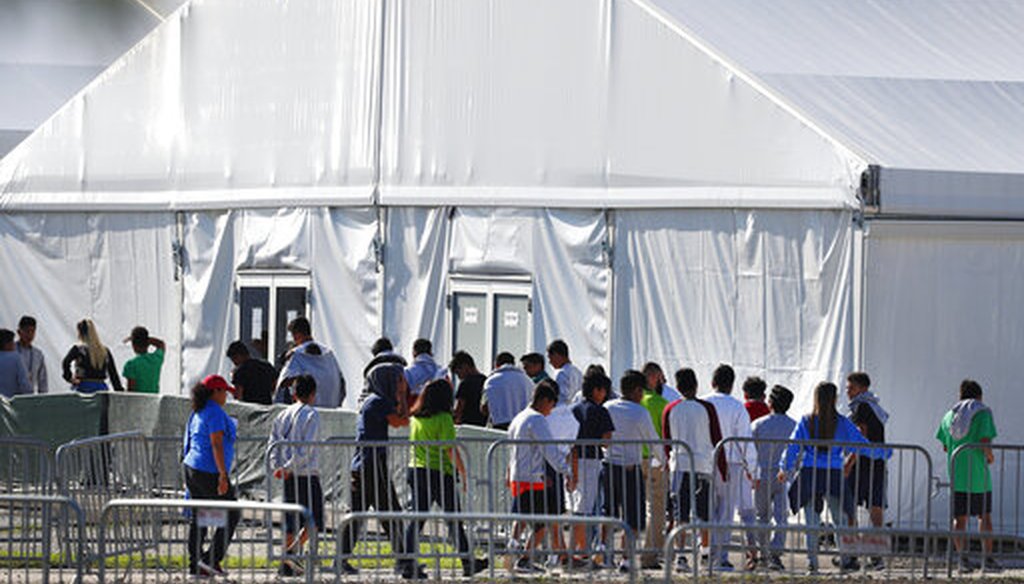Stand up for the facts!
Our only agenda is to publish the truth so you can be an informed participant in democracy.
We need your help.
I would like to contribute

In this Feb. 19, 2019 file photo, children line up to enter a tent at the temporary shelter for unaccompanied children in Homestead, Fla. (AP)
The arrival of more children and families at the southwest border is leading to overcrowding at border processing facilities and prompting Democratic lawmakers to scrutinize how the Trump administration is handling the surge.
A delegation of Democratic members of Congress, including U.S. Rep. Alexandria Ocasio-Cortez, D-N.Y., went down to the border to visit facilities where apprehended migrants are processed. They said conditions were condemnable.
"What we saw today was unconscionable. No child should ever be separated from their parent. No child should ever be taken from their family," Ocasio-Cortez said July 1. "No woman should ever be locked up in a pen when they have done no harm to another human right. They should be given water. They should be given basic access to human rights."
The immigration system is complex, and once migrants reach U.S. soil, they can be held in a variety of facilities. Here’s an overview of where migrants are held and why there’s an ongoing debate about their detention conditions.
What sparked renewed attention on immigrant detention centers?
The Trump administration says the United States is currently facing a crisis as the number of people arriving at the southwest border increases month to month and outpaces apprehensions from last fiscal year.
At the southwest border, Border Patrol made around 593,500 apprehensions in the first eight months of fiscal year 2019. In all of fiscal year 2018, it made close to 396,600 apprehensions.
Based on recent unannounced visits to Border Patrol facilities, government investigators have flagged serious concerns about overcrowding and prolonged detentions at these locations, saying the conditions "represent an immediate risk to the health and safety" of immigration officials and detainees. The findings in the investigative reports and photos have renewed criticism of the Trump administration’s detention practices.
Who oversees the detention of immigrants?
Once in federal custody, immigrants are held in a variety of facilities led by different agencies — from processing centers operated by Customs and Border Protection, to detention facilities run by Immigration and Customs Enforcement, to shelters for children under the supervision of the Office of Refugee Resettlement within the Health and Human Services Department.
People held by ICE are either awaiting deportation or a decision on their immigration case. They are held throughout the country, including in federally-owned centers, contracted county jails, and contracted facilities owned by private prison companies. The average daily population in ICE detention fluctuates and was around 45,000 people as of March 2019.
Immigration officials refer children apprehended at the border to the Office of Refugee Resettlement, an agency that is part of HHS. Each year, the office oversees tens of thousands of migrant children, most of whom have come alone without a parent or guardian.
Children stay in shelters before being handed over to the care of a sponsor, often a parent in the United States, or another family member. Whether in federal care or with a sponsor, the children still go through immigration proceedings to determine whether they can remain in the United States.
Private companies, as well as nonprofits, can be contracted by the government to run facilities holding migrant children. For instance, Caliburn International, a private for-profit company, runs a center in Homestead, Fla.
A Texas nonprofit recently was announced to have received a $300 million contract to run a new temporary shelter for child migrants in Carrizo Springs, Texas, and provide 1,300 beds, according to a notice published July 2, 2019, in the Federal Register.
What have investigators said about conditions at ICE facilities?
The U.S. government is responsible for ensuring that facilities contracted by ICE adhere to federal standards guiding the care and treatment of migrants. Over the years, the Office of Inspector General within the Department of Homeland Security has highlighted poor conditions and violations of standards at some federally-run and contracted facilities.
In 2017, investigators examined whether ICE immigration detention inspections ensured adequate oversight and compliance with detention standards. Contracted facilities were part of the scope, according to the inspector general report published June 2018.
The report concluded that ICE wasn’t adequately monitoring facilities and that its "difficulties with monitoring and enforcing compliance with detention standards stretch back many years and continue today."
Other groups outside the government have also flagged issues at ICE facilities.
The Southern Poverty Law Center conducted a seven-month investigation of six immigrant detention facilities in the South. The group analyzed three private facilities and three run by county sheriffs.
"From facility to facility, their stories are remarkably similar accounts of abuse, neglect and rights denied — symptoms of an immigrant detention system where the failures of the nation’s immigration system intersect with the failures of its prison system," the Southern Poverty Law Center said in a 2016 report.
What are the conditions in child migrant centers?
Migrant children spend an average of fewer than 45 days at children’s shelters, according to a frequently asked questions page on the Office of Refugee Resettlement website, last reviewed May 15, 2019.
The average number of children in care of HHS has ranged from 11,151 to 14,226 so far in fiscal year 2019, according to HHS.
Patrick Fisher, a public affairs and media specialist of the Administration for Children and Families at the Department of Health and Human Services, told PolitiFact that all care providers, including the Homestead Temporary Shelter in Florida for unaccompanied children, are required to "report incidents affecting a child’s health, well-being and safety," and specifically "significant incidents." The latter include "verbal threats by one youth against another youth to physical altercations or allegations of sexual abuse."
Several Democratic presidential candidates went to the Homestead center (although they were not allowed to enter) at the time of the presidential debates in Miami, amid demands for its closure. "We were stonewalled today by an administration and a private contractor that does not want us to see what is happening behind those walls," said presidential candidate Julián Castro, outside the facility.
The center in Homestead, which is holding 2,300 children of its 3,200 capacity, is a temporary influx shelter. Another is slated to open in Oklahoma at a facility that was the site of a World War II internment camp, according to CBS News.
What action has Congress taken to address private child migrant centers?
Trump signed a $4.5 billion humanitarian aid bill into law July 1, 2019. The bipartisan bill divvies up the appropriations by the agencies that will implement the law, which are those within the Justice Department, DHS, and HHS. Some of that funding specifically goes to getting children out of large-scale shelters faster.
Another bill currently before a committee in the House of Representatives seeks to close temporary emergency shelters for unaccompanied minors. U.S. Rep. Judy Chu, D-Calif., in February introduced the Shut Down Child Prison Camps Act, to prohibit HHS from operating unlicensed temporary emergency shelters for unaccompanied immigrant children. The bill’s chances of getting through the Republican-controlled Senate, however, are low.
In addition to that bill, the House Oversight and Reform Committee will hold hearings on the separation and treatment of migrant children, according to a statement by the committee.
"The committee needs to hear directly from the heads of these agencies as soon as possible in light of the almost daily reports of abuse and defiance," said Rep. Elijah E. Cummings, D-Md., chairman of the committee.
What are President Donald Trump’s plans for immigration detention?
Trump’s approach is at odds with that of House Democrats. As part of his hard-line approach to immigration, Trump seeks to increase detention space to keep more migrants in custody. Lack of detention space has consistently been one of the reasons why immigration authorities release immigrants.
Trump’s fiscal year 2020 budget plan asks for $2.7 billion for 54,000 detention beds and requests the creation of a Border Security and Immigration Enforcement Fund. The fund would be used to expand immigration detention capacity to 60,000 beds (including 10,000 family detention beds) and to hire more staff to enforce and litigate immigration laws.
Our Sources
Email interview with Patrick Fisher, a public affairs/media specialist of the Administration for Children and Families at the Department of Health and Human Services, July 3, 2019
Alexandria Ocasio-Cortez tweet, July 1, 2019
Alexandria Ocasio-Cortez tweet, June 24, 2019
Vox, "People drinking out of toilets": AOC and other Democrats share details from their Texas border facility tour, July 2, 2019
Congressional Research Service, Recent Migration to the United States from Central America: Frequently Asked Questions, January 29, 2019
Office of Refugee Resettlement, Unaccompanied Alien Children Frequently Asked Questions, July 9, 2018
PBS, Nearly 6,000 complaints of abuse at migrant children shelters made over four years, February 26, 2019
The New York Times, Thousands of Immigrant Children Said They Were Sexually Abused in U.S. Detention Centers, Report Says, February 27, 2019
CBS News, "Man camp" holding facility for migrant children opens with possible $300 million contract, July 2, 2019
Congress.org, H.R.3401 - Emergency Supplemental Appropriations for Humanitarian Assistance and Security at the Southern Border Act, 2019, July 1, 2019
Congress.org, H.R.1069 - Shut Down Child Prison Camps Act, March 25, 2019
Department of Health and Human Services, Latest UAC Data – FY2019, No date
Federal Register, Announcement of the Intent To Issue One OPDIV-Initiated Supplement to BCFS Health and Human Services Under the Standing Announcement for Residential (Shelter) Services for Unaccompanied Alien Children, HHS-2017-ACF-ORR-ZU-1132, July 1, 2019
Committee on Oversight and Reform, Cummings Announces Hearing Next Week With Acting DHS and CBP Heads on Separation and Treatment of Immigrant Children, July 2, 2019
The Guardian, Sanders campaign says he will close migrant detention centers if elected, June 26, 2019
Newsweek, These 2020 Democratic Presidential Candidates Say They Would End Migrant Detention If Elected, July 2, 2019
OpenSecrets.org, GEO Group Contributions to Federal Candidates, 2018 cycle, No date
OpenSecrets.org, CoreCivic Contributions to Federal Candidates, 2018 cycle, No date
The New York Times, Some Contractors Housing Migrant Children Are Familiar to Trump’s Inner Circle, July 4, 2018
Twitter, @ABC tweet, July 1, 2019
MPI, Profiting from Enforcement: The Role of Private Prisons in U.S. Immigration Detention, May 2, 2018
White House, Budget proposal for FY 2020
PolitiFact, How do standards measure up at immigration detention centers? A special report, Sept. 6, 2017
DHS OIG, Concerns about ICE Detainee Treatment and Care at Detention Facilities, Dec. 11, 2017; ICE’s Inspections and Monitoring of Detention Facilities Do Not Lead to Sustained Compliance or Systemic Improvements, June 26, 2018
SPLC, Shadow Prisons: Immigrant Detention in the South, Nov. 21, 2018
Email exchange, CBP press office, July 2, 2019








































